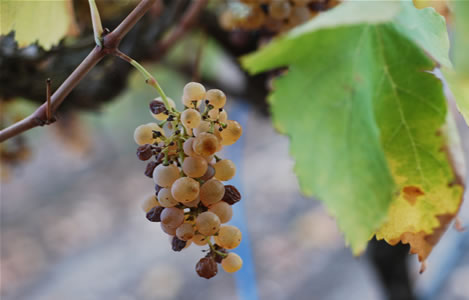|
Teetotaller gets tipsy & turns winemaker
 Photograph: Preeti Verma Lal
Photograph: Preeti Verma Lal
If you were tipsy how would you describe life? As a cabernet. Or as a series of oak barrels symmetrically arranged? Or would you sit by the vineyards with burnished leaves and intricate tendrils and attain the peace that eludes us all? Or, would you don a white apron, fiddle with the grenache, shiraz and mourvedre and fabricate a new concoction and call it the perfect wine – and life. Standing in the largest cellar in the southern hemisphere, I was not only bewildered about the definition but was also getting scatty with the whiff of the fermenting grapes in thousands of oak barrels in the 144-year old Penfolds Winery. Perhaps it takes a Barossa Valley, one of the largest wine-producing regions in Australia, to get a teetotaler like me tipsy.
Perhaps I should have paid heed to the warning of Ralf Hadzic, who runs Life Is A Cabernet tours. Hadzic has a funny bone the size of a water melon, he guffaws loudly, he is gregarious to his last bone and has myriad gags in his repertoire. Hadzic’s warning came buttressed with facts about the Barossa Valley – vineyards sprawled over 700 sq kms, 600 growers, 75 wineries and so much wine that it could get the Pacific burgundy and drunk. But that balmy morning in Barossa I slammed shut all facts misconstruing them as the quip of a raconteur. And I paid for it, I got wobbly.
I was not the only one to have gone wrong that day. Even Barossa began life with a spelling gaffe. Nearly 160 years ago an entire bunch of Europeans were brought from Silesia (now in Poland) to plant vineyards. Mapping it, Surveyor General Colonel William Light christened the area Barrosa, after the Spanish town where the French lost a battle against the English. No one carbon-dates that spelling howler, one day the husky Barrosa became the elegant Barossa and added to itself not just vineyards but also storybook churches, large barns, pug cottages, houses made of bluestone and sandstone and streets with palm tree trimmings.
As I walked past the barrels and large steel tanks in Penfolds, I could see the big ticket Penfolds Grange that was first made in 1951. Made from grapes of old, low-yielding vines, Barossa is now proud of the limited edition Grange that, in 2001, was labelled the Most Reverred Australian Wine. However, they are not the only special ones under the Penfolds tag. According to Suzi Hilder, assistant vineyard manager, the 120-year old Block 42 Cabernet Sauvignon vines are not only the oldest of its kind in the world, they also have “individual personalities”.
If you have longed to make your own wine concoction, in Penfolds you can wear an apron, walk up the creaky stairs into the lab and make your own blend, the first of its kind in Australia. I looked at the Petri dishes and the measuring equipment and gave up being a wine maker, though I did carry back a wine bottle that came embellished with my name and a new job tag: Assistant Wine Maker.
In Barossa, I was to learn more about wine making at Wolf Blass and Peter Lehmann Wineries. Wolf Blass, like all fascinating stories go, came to Barossa with $ 100 in his pocket to “contribute something to the Australian wine industry.” Blass started in a tin shed and fermented with such passion that he was honoured as the world’s best winemaker at the International Wine and Spirits competition in 1992 and 2002. Other than the fabled Black Label and the recent Gold Label range, at Wolf Blass you can pick up everything else made of wine: chocolates, cookies, candles, even soaps milled out of grape skin and seeds to scrub yourself clean!
Hopping from one winery to another, I was mesmerized by the palm promenades that became more an alibi to provide employment to the labourers during the Great Depression than as ornamentation for the Valley. However, sitting by fireplace in Peter Lehmann’s elegantly done tasting room, I saw bottle labels that could befit a frame in an upscale museum. Here the Shiraz that is not only made by the sixth generation original 1840s vignerons they are also honoured by paeans in Eight Songs, a book that romanticizes its deep garnet hue, French oak smokiness and regal character… Midway a sentence I wondered whether the ode was to an aged wine or a willowy woman.
I could not have left Barossa without looking greedily at the verjuice, burnt fig jam, Seville glaze, lemon curd at gourmand Maggie Beer’s Farm, who hosts the famous The Cook and the Chef Show on ABC. In Australia, calling yourself a foodie would be blasphemy if you have not joined Beer’ Food Club.
I had thought I had frittered away the wooziness borrowed from the whiff escaping off the barrel bungs. But I realized I was still tipsy when I lost a secret at the Whispering Wall, one of the first concrete arch dams in the world. That wall just cannot a secret (must be a woman!) - your whisper can actually be heard 140 metres away. Surely not as a murmur but almost amplified on a 4,000-watt speaker.
At Barossa, nobody complains of the evaporated wine. You would call them generous when you learn that out of 120 barrels, wine equivalent to one barrel evaporates hastily into thin air. The winemakers do not whine, they call it the Angel’s share. In Barossa a thought struck me. How about being born an angel in Barossa? Imagine flapping wings in heavens redolent with the bouquet of wine. My heart suggested slyly. But the voyeur of a Whispering Wall heard that. And I lost my secret – and an ‘angelic’ dream - in Barossa. I just hope the gods heard that!
Published
in The Economic Times, 2008
|

